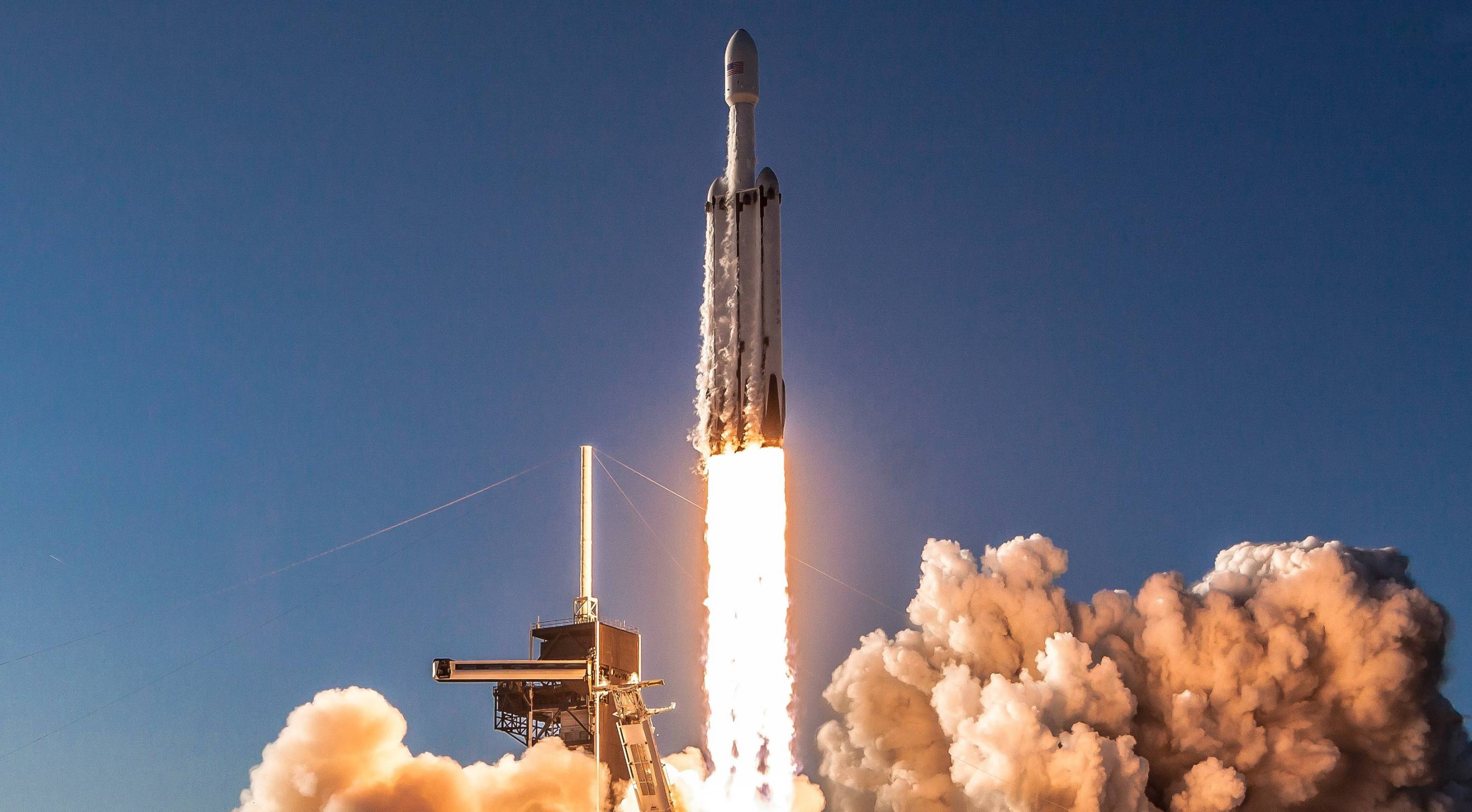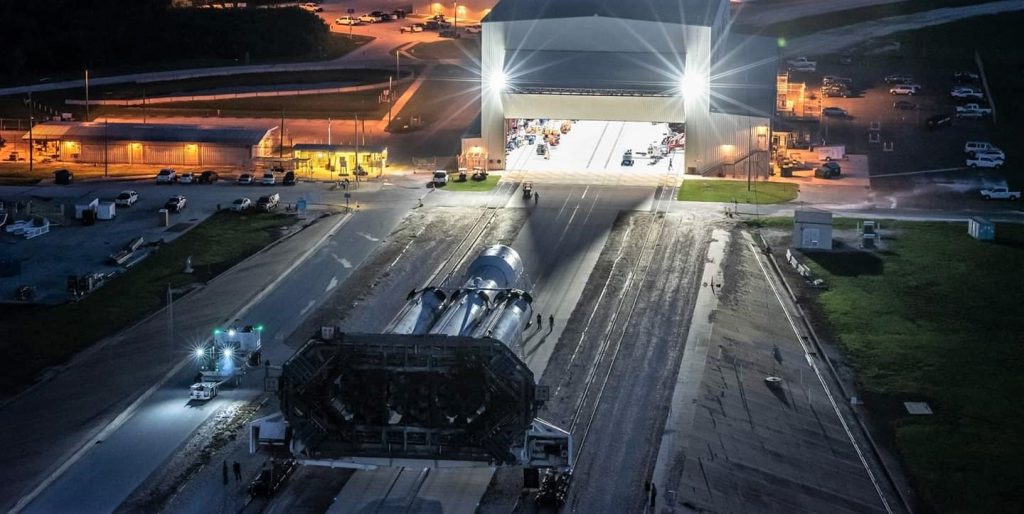

News
SpaceX schedules first Falcon Heavy launch in two years in early October
For the first time in more than two years, SpaceX has a firm launch date for its next Falcon Heavy mission: October 9th, 2021.
Revealed on September 7th as part of a US Space Systems Command presentation at the 2021 Small Payload Ride Share Symposium, October 9th now appears to be the military’s official target date for SpaceX’s fourth Falcon Heavy launch ever. Currently the most powerful and capable commercial rocket in operation and likely to remain so – perhaps alongside Starship – for years to come, Falcon Heavy debuted in February 2018, successfully delivering a mock payload into interplanetary space.
After another 14 months of work, SpaceX then debuted Falcon Heavy Block 5 – an upgraded version of the rocket that took advantage of all of Block 5’s reusability, reliability, and performance improvements. Just two months after Falcon Heavy Block 5’s inaugural April 2019 launch, SpaceX launched the rocket for the third time, supporting a US Air Force rideshare mission, reusing both of Flight 2’s side boosters, and giving the US military a firsthand demonstration of the rocket’s capabilities. However, Falcon Heavy has not flown once since then.
For mostly unknown reasons, Falcon Heavy’s fourth launch – a US military mission known as USSF-44 (formerly AFSPC-44) – has gradually slipped from a late-2020 target to Q1, Q2, Q3, and finally Q4 (October) 2021. SpaceX only began qualifying USSF-44’s Falcon Heavy boosters at its McGregor, Texas test facilities in late September 2020, a few weeks after delays from late-2020 to February 2021 and June 2021 were quietly announced. At that point, the US was deep into the throes of the COVID-19 pandemic’s local peak.
Only in May 2021 did the US military finally directly address major USSF-44 and USSF-52 delays, blaming them on “payload readiness.” Given that the Space Force never blamed SpaceX or rocket availability for what is likely to be a full year of launch delays, the implication is that likely satellite manufacturers Northrop Grumman, Lockheed Martin, Maxar, or Boeing have run into major technical issues. It’s also possible that those payload-side delays have been caused by a combination of supply chain issues and constraints brought on by the ongoing global pandemic.
Meanwhile, USSF-44’s all-new Falcon Heavy rocket appears to have been at Cape Canaveral and more or less ready for flight since Q2 2021 and SpaceX has been hard at work qualifying at least two more Falcon Heavy center cores for at least two additional missions scheduled in H1 2022.
Scheduled to launch no earlier than (NET) October 9th, Falcon Heavy #4 will likely roll out to Kennedy Space Center Pad 39A around 5-7 days prior for a crucial static fire test and pad shakedown. SpaceX is currently scheduled to launch Crew Dragon’s all-private Inspiration4 mission as early as September 14th, giving the company around three weeks to modify Pad 39A and its transporter/erector, gather all four USSF-44 Falcon Heavy stages, and assemble the rocket. Another Crew Dragon mission is then scheduled to launch as early as October 31st, again leaving SpaceX less than three weeks to reconfigure Pad 39A.
Successfully completing that back-to-back-to-back Dragon-FH-Dragon manifest on schedule will be a significant challenge and delays are probably more likely than not. Nevertheless, Falcon Heavy will likely roll out to the launch pad for the first time in more than two years less than a month from today.

News
Tesla begins Robotaxi certification push in Arizona: report
Tesla seems serious about expanding its Robotaxi service to several states in the coming months.

Tesla has initiated discussions with Arizona transportation regulators to certify its driverless Robotaxi service in the state, as per a recent report from Bloomberg News. The move follows Tesla’s launch of its Robotaxi pilot program in Austin, Texas, as well as CEO Elon Musk’s recent comments about the service’s expansion in the Bay Area.
The Arizona Department of Transportation confirmed to Bloomberg that Tesla has reached out to begin the certification process for autonomous ride-sharing operations in the state. While details remain limited, the outreach suggests that Tesla is serious about expanding its driverless Robotaxi service to several territories in the coming months.
The Arizona development comes as Tesla prepares to expand its service area in Austin this weekend, as per CEO Elon Musk in a post on X. Musk also stated that Tesla is targeting the San Francisco Bay Area as its next major market, with a potential launch “in a month or two,” pending regulatory approvals.
Tesla first launched its autonomous ride-hailing program on June 22 in Austin with a small fleet of Model Y vehicles, accompanied by a Tesla employee in the passenger seat to monitor safety. While still classified as a test, Musk has said the program will expand to about 1,000 vehicles in the coming months. Tesla will later upgrade its Robotaxi fleet with the Cyercab, a two-seater that is designed without a steering wheel.
Sightings of Cybercab castings around the Giga Texas complex suggests that Tesla may be ramping the initial trial production of the self-driving two-seater. Tesla, for its part, has noted in the past that volume production of the Cybercab is expected to start sometime next year.
In California, Tesla has already applied for a transportation charter-party carrier permit from the state’s Public Utilities Commission. The company is reportedly taking a phased approach to operating in California, with the Robotaxi service starting with pre-arranged rides for employees in vehicles with safety drivers.
News
Tesla sets November 6 date for 2025 Annual Shareholder Meeting
The automaker announced the date on Thursday in a Form 8-K.

Tesla has scheduled its 2025 annual shareholder meeting for November 6, addressing investor concerns that the company was nearing a legal deadline to hold the event.
The automaker announced the date on Thursday in a Form 8-K submitted to the United States Securities and Exchange Commission (SEC). The company also listed a new proposal submission deadline of July 31 for items to be included in the proxy statement.
Tesla’s announcement followed calls from a group of 27 shareholders, including the leaders of large public pension funds, which urged Tesla’s board to formally set the meeting date, as noted in a report from The Wall Street Journal.
The group noted that under Texas law, where Tesla is now incorporated, companies must hold annual meetings within 13 months of the last one if requested by shareholders. Tesla’s previous annual shareholder meeting was held on June 13, 2024, which placed the July 13 deadline in focus.
Tesla originally stated in its 2024 annual report that it would file its proxy statement by the end of April. However, an amended filing on April 30 indicated that the Board of Directors had not yet finalized a meeting date, at least at the time.
The April filing also confirmed that Tesla’s board had formed a special committee to evaluate certain matters related to CEO Elon Musk’s compensation plan. Musk’s CEO performance award remains at the center of a lengthy legal dispute in Delaware, Tesla’s former state of incorporation.
Due to the aftermath of Musk’s legal dispute about his compensation plan in Delaware, he has not been paid for his work at Tesla for several years. Musk, for his part, has noted that he is more concerned about his voting stake in Tesla than his actual salary.
At last year’s annual meeting, TSLA shareholders voted to reapprove Elon Musk’s compensation plan and ratified Tesla’s decision to relocate its legal domicile from Delaware to Texas.
Elon Musk
Grok coming to Tesla vehicles next week “at the latest:” Elon Musk
Grok’s rollout to Tesla vehicles is expected to begin next week at the latest.

Elon Musk announced on Thursday that Grok, the large language model developed by his startup xAI, will soon be available in Tesla vehicles. Grok’s rollout to Tesla vehicles is expected to begin next week at the latest, further deepening the ties between the two Elon Musk-led companies.
Tesla–xAI synergy
Musk confirmed the news on X shortly after livestreaming the release of Grok 4, xAI’s latest large language model. “Grok is coming to Tesla vehicles very soon. Next week at the latest,” Musk wrote in a post on social media platform X.
During the livestream, Musk and several members of the xAI team highlighted several upgrades to Grok 4’s voice capabilities and performance metrics, positioning the LLM as competitive with top-tier models from OpenAI and Google.
The in-vehicle integration of Grok marks a new chapter in Tesla’s AI development. While Tesla has long relied on in-house systems for autonomous driving and energy optimization, Grok’s integration would introduce conversational AI directly into its vehicles’ user experience. This integration could potentially improve customer interaction inside Tesla vehicles.
xAI and Tesla’s collaborative footprint
Grok’s upcoming rollout to Tesla vehicles adds to a growing business relationship between Tesla and xAI. Earlier this year, Tesla disclosed that it generated $198.3 million in revenue from commercial, consulting, and support agreements with xAI, as noted in a report from Bloomberg News. A large portion of that amount, however, came from the sale of Megapack energy storage systems to the artificial intelligence startup.
In July 2023, Musk polled X users about whether Tesla should invest $5 billion in xAI. While no formal investment has been made so far, 68% of poll participants voted yes, and Musk has since stated that the idea would be discussed with Tesla’s board.
-

 Elon Musk1 week ago
Elon Musk1 week agoTesla investors will be shocked by Jim Cramer’s latest assessment
-

 Elon Musk3 days ago
Elon Musk3 days agoElon Musk confirms Grok 4 launch on July 9 with livestream event
-

 Elon Musk14 hours ago
Elon Musk14 hours agoxAI launches Grok 4 with new $300/month SuperGrok Heavy subscription
-

 News7 days ago
News7 days agoTesla Model 3 ranks as the safest new car in Europe for 2025, per Euro NCAP tests
-

 Elon Musk2 weeks ago
Elon Musk2 weeks agoA Tesla just delivered itself to a customer autonomously, Elon Musk confirms
-

 Elon Musk1 week ago
Elon Musk1 week agoxAI’s Memphis data center receives air permit despite community criticism
-

 Elon Musk2 weeks ago
Elon Musk2 weeks agoTesla’s Omead Afshar, known as Elon Musk’s right-hand man, leaves company: reports
-

 News2 weeks ago
News2 weeks agoXiaomi CEO congratulates Tesla on first FSD delivery: “We have to continue learning!”

















